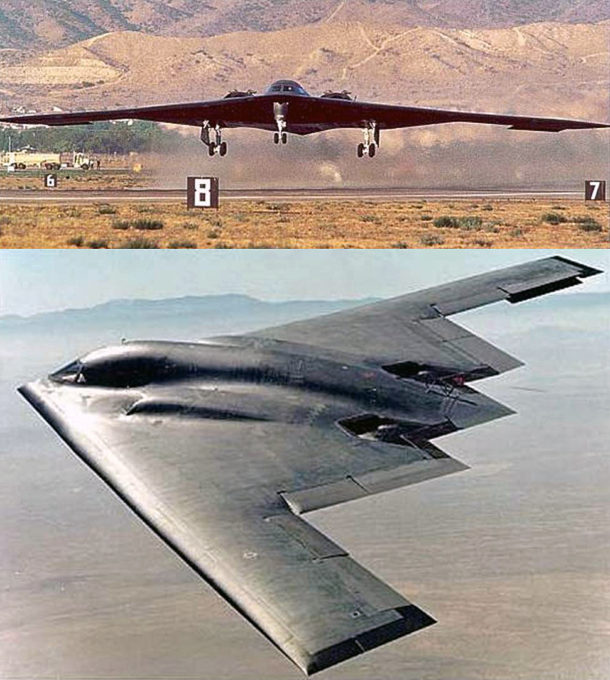
Twenty-seven years ago this month, the USAF/Northrop B-2 Stealth Strategic Bomber flew for the first time. The aircrew for the B-2’s maiden trip upstairs included Northrop B-2 Division Chief Test Pilot Bruce J. Hinds (command pilot) and B-2 Combined Test Force Commander USAF Col. Richard S. Couch (co-pilot).
The B-2 traces it lineage to a variety of Northrop flying wing aircraft including the piston-powered YB-35 and jet-propelled YB-49. These 1940’s-era experimental aircraft served as important stepping stones in the evolution of large flying wing technology.
An all-wing aircraft represents an aerodynamically-optimal configuration from the standpoint of high lift, low drag and therefore high lift-to-drag ratio. These favorable aerodynamic attributes translate to high levels of range performance and load-carrying capability. In addition, the type’s high aspect ratio and slim profile provide for more favorable low observable characteristics than traditional fuselage-wing-empennage aircraft geometries.
Arguably the most challenging aspects of creating an all-wing aircraft have to do with flight control and handling qualities. The crash of the second YB-49 flying wing in June of 1948 underscored the insufficiency of aerospace technology at that time to handle these design challenges. It was not until the advent of modern flight control avionics during the 1980’s that the full potential of a flying wing aircraft would be realized.
The B-2 is only 69 feet in length, but has a wing span of 172 feet and a wing area of 5,140 square feet. Gross take-off and empty weights are 336,500 lbs and 158,000 lbs, respectively. Embedded within the wings are a quartet of fuel-efficient F118-GE-100 turbofan engines, each generating 17,300 lbs of thrust. The aircraft has a top speed of about Mach 0.85, an unrefueled range of 6,000 nm and a service ceiling of 50,000 feet. Maximum ordnance load is 50,000 lbs.
B-2 AV-1 (Spirit of America; S/N 82-1066) took-off for the first time from Air Force Plant 42 in Palmdale, California on Monday, 17 July 1989. Supported by F-16 chase aircraft, the majestic flying wing flew a 2 hour 12 minute test mission which concluded with a landing at nearby Edwards Air Force Base. As a first flight precaution, the entire mission was flown with the landing gear down.
The first B-2 airframe to enter the operational inventory was AV-8, the Spirit of Missouri (S/N 88-0329). It did so on 31 March 1994. While initial plans called for a production run of 132 aircraft, only 21 B-2 airframes were actually built. With the 2008 loss of the Spirit of Kansas shortly after take-off from Andersen Air Force Bas in Guam, 20 of these aircraft remain in active service today.
Whiteman Air Force Base in Missouri serves as Air Force’s home for the B-2. From there, the majestic flying wing has flown a multitude of global strike missions to deliver a variety of ordnance with pinpoint accuracy. To date, the B-2 has successfully engaged targets in Kosovo, Afganistan, Iraq and Libya. The B-2 is truly a technological marvel and a national defense asset. As such, it may be expected to be a vital part of the Air Force’s active inventory for decades to come.
